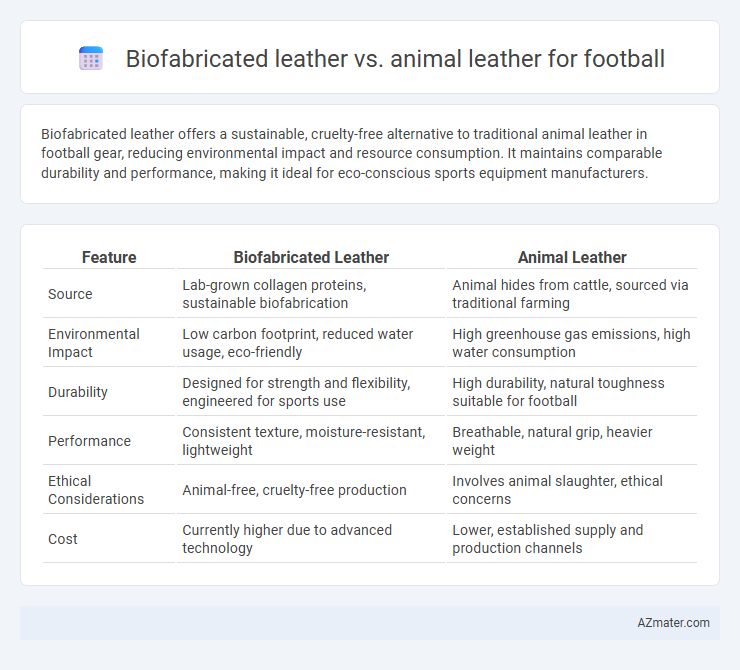Biofabricated leather offers a sustainable, cruelty-free alternative to traditional animal leather in football gear, reducing environmental impact and resource consumption. It maintains comparable durability and performance, making it ideal for eco-conscious sports equipment manufacturers.
Table of Comparison
| Feature | Biofabricated Leather | Animal Leather |
|---|---|---|
| Source | Lab-grown collagen proteins, sustainable biofabrication | Animal hides from cattle, sourced via traditional farming |
| Environmental Impact | Low carbon footprint, reduced water usage, eco-friendly | High greenhouse gas emissions, high water consumption |
| Durability | Designed for strength and flexibility, engineered for sports use | High durability, natural toughness suitable for football |
| Performance | Consistent texture, moisture-resistant, lightweight | Breathable, natural grip, heavier weight |
| Ethical Considerations | Animal-free, cruelty-free production | Involves animal slaughter, ethical concerns |
| Cost | Currently higher due to advanced technology | Lower, established supply and production channels |
Introduction to Leather in Football Manufacturing
Biofabricated leather offers a sustainable alternative to traditional animal leather in football manufacturing, reducing environmental impact while maintaining performance standards. Animal leather, primarily sourced from cattle, has long been valued for its durability and natural grip, essential for high-quality footballs. Innovations in biofabrication produce leather that mimics these properties with enhanced consistency and fewer ethical concerns, appealing to manufacturers aiming for eco-friendly and ethical sports equipment.
What is Biofabricated Leather?
Biofabricated leather is a sustainable alternative to traditional animal leather, created through biotechnological processes that grow collagen or other proteins without the need for animal hides. This innovative material offers comparable durability, flexibility, and performance required for football, while significantly reducing environmental impact and ethical concerns associated with animal farming. Biofabricated leather presents a promising solution for the sports industry by combining high-performance characteristics with eco-friendly production methods.
Traditional Animal Leather: An Overview
Traditional animal leather, derived primarily from cowhide and sheepskin, has been the standard material for footballs due to its durability, grip, and natural feel. Its porous structure allows for better sweat absorption and control during play, making it favored by professional athletes worldwide. However, animal leather requires extensive processing, involving tanning and chemical treatments, raising environmental and ethical concerns compared to emerging alternatives like biofabricated leather.
Environmental Impact: Biofabricated vs Animal Leather
Biofabricated leather significantly reduces environmental impact compared to animal leather by eliminating the need for livestock farming, which accounts for substantial greenhouse gas emissions, water consumption, and land use. The production of biofabricated leather uses fewer natural resources and generates less pollution, promoting sustainability in football gear manufacturing. In contrast, animal leather production involves ethical concerns and contributes heavily to deforestation, methane emissions, and chemical waste from tanning processes.
Performance and Durability Comparison
Biofabricated leather offers enhanced moisture resistance and consistent tensile strength, making it highly suitable for the dynamic demands of football footwear compared to traditional animal leather. Animal leather provides natural breathability and a well-established flexibility but may degrade faster under intense wear and exposure to sweat. Durability tests show biofabricated leather maintains shape and structural integrity longer, supporting better long-term performance on the field.
Cost Analysis and Scalability
Biofabricated leather offers a cost-effective alternative to traditional animal leather in football manufacturing by reducing expenses related to livestock rearing, processing, and environmental compliance. Scalability is enhanced through controlled lab production that allows rapid customization and mass production, overcoming the limitations of animal leather's dependency on agricultural cycles and geographic constraints. The increasing investment in biofabrication technology further drives down costs while supporting scalable output to meet the growing global demand for sustainable sports equipment.
Ethical Considerations in Leather Sourcing
Biofabricated leather offers a sustainable and cruelty-free alternative to traditional animal leather, eliminating the ethical concerns related to animal slaughter and habitat destruction in football gear production. The sourcing of biofabricated leather reduces the carbon footprint and water consumption dramatically compared to animal-based leather, making it an environmentally responsible choice for football manufacturers. Ethical considerations in leather sourcing highlight biofabricated leather's potential to transform the industry by prioritizing animal welfare and ecological preservation.
Consumer Perception and Market Trends
Biofabricated leather is gaining consumer acceptance in the football industry due to its sustainability and cruelty-free attributes, appealing to environmentally conscious athletes and fans. Market trends indicate a growing demand for biofabricated leather as brands invest in eco-friendly alternatives to traditional animal leather, aligning with global initiatives for reduced carbon footprints. Despite animal leather's historical dominance, the shift toward biofabricated options reflects a broader consumer preference for innovative materials without compromising performance and durability in football gear.
Innovation and Future Prospects in Football Materials
Biofabricated leather offers revolutionary innovation in football materials, providing enhanced durability, sustainability, and consistent performance compared to traditional animal leather. Its composition allows for precise customization of texture and water resistance, critical for football manufacturing standards and athlete performance. The future prospects of biofabricated leather in football include widespread adoption due to environmental benefits and advancements in material science that improve product lifespan and reduce ecological impact.
Conclusion: Which Leather is the Future of Football?
Biofabricated leather offers superior sustainability, reducing carbon footprint and ethical concerns compared to traditional animal leather in football. Its consistent quality and enhanced durability improve player performance and equipment longevity. As demand for eco-friendly materials rises, biofabricated leather represents the future of football, balancing innovation with environmental responsibility.

Infographic: Biofabricated leather vs Animal leather for Football
 azmater.com
azmater.com